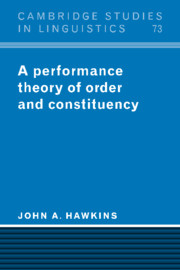Book contents
- Frontmatter
- Contents
- Preface
- Acknowledgments
- List of abbreviations
- 1 Introduction
- 2 The grammaticalization of processing principles
- 3 Early immediate constituents
- 4 Testing EIC's performance predictions
- 5 Testing EIC's grammatical predictions
- 6 Grammaticalized node construction
- 7 Conclusions
- Envoi
- Notes
- References
- Index of names
- Index of languages
- Subject index
6 - Grammaticalized node construction
Published online by Cambridge University Press: 18 September 2009
- Frontmatter
- Contents
- Preface
- Acknowledgments
- List of abbreviations
- 1 Introduction
- 2 The grammaticalization of processing principles
- 3 Early immediate constituents
- 4 Testing EIC's performance predictions
- 5 Testing EIC's grammatical predictions
- 6 Grammaticalized node construction
- 7 Conclusions
- Envoi
- Notes
- References
- Index of names
- Index of languages
- Subject index
Summary
In ch. 3.2 I defined two parsing principles, Mother Node Construction (MNC) and Immediate Constituent Attachment (ICA). The former is a construction principle: it defines a method for recognizing abstract phrasal groupings on the basis of terminal elements within a parse string. Without such a principle, constituent structure would not be recognizable on-line, there would be no such thing as a Constituent Recognition Domain (CRD), and so on. Clearly, the construction of abstract syntactic nodes, and the correct assignment of words to their appropriate dominating nodes, is a vital prerequisite for the everyday use of human language.
This chapter will consider the theory of node construction in more detail. MNC is an extremely general and all-pervasive principle which has been largely sufficient to illustrate the wide range of ElC-derived word order predictions presented in chs. 4 and 5. But the construction of a higher node by an immediate daughter is not the only way of adding non-terminal structure to the terminal categories of the parse string, and I have already alluded to the existence of some additional construction principles in previous chapters. The purpose of this chapter is to define these principles and to consider the predictions they make for variation in both category selection and ordering across languages. A further goal is to consider how grammars have responded to the parser's need to recognize higher constituent structure in a rapid and efficient manner.
- Type
- Chapter
- Information
- A Performance Theory of Order and Constituency , pp. 342 - 408Publisher: Cambridge University PressPrint publication year: 1995



